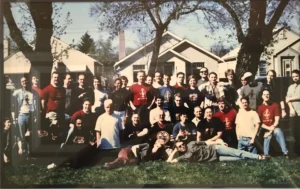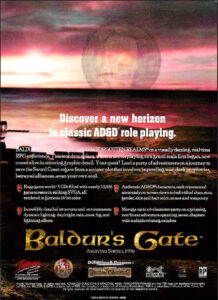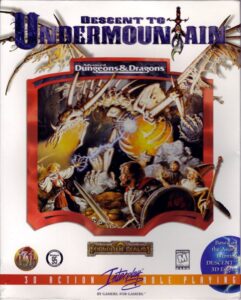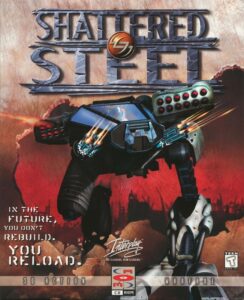In December of 1997, Interplay Entertainment released Descent to Undermountain, the latest licensed Dungeons & Dragons computer game. It’s remembered today, to whatever extent it’s remembered at all, as one of the more infamous turkeys of an era with more than its share of over-hyped and half-baked creations, a fiasco almost on par with Battlecruiser 3000AD or Daikatana. The game was predicated on the dodgy premise that Dungeons & Dragons would make a good fit with the engine from Descent, Interplay’s last world-beating hit — and also a hit that was, rather distressingly for Brian Fargo and his colleagues, more than two years in the past by this point.
Simply put, Undermountain was a mess, the kind of career-killing disaster that no self-respecting game developer wants on his CV. The graphics, which had been crudely up-scaled from the absurdly low resolution of 320 X 240 to a slightly more respectable 640 X 480 at the last minute, still didn’t look notably better than those of the five-year-old Ultima Underworld. The physics were weirdly floaty and disembodied, perhaps because the engine had been designed without any innate notion of gravity; rats could occasionally fly, while the corpses of bats continued to hover in midair long after shaking off their mortal coil. In design terms as well, Undermountain was trite and rote, just another dungeon crawl in the decade-old tradition of Dungeon Master, albeit not executed nearly so well as that venerable classic.
Computer Gaming World, hot on the heels of giving a demo of Undermountain a splashy, breathless write-up (“This game looks like a winner…”), couldn’t even muster up the heart to print a proper review of the underwhelming finished product. The six-sentence blurb the magazine did deign to publish said little more than that “the search for a good Dungeons & Dragons role-playing game continues, because Descent to Undermountain is certainly not it.” The website GameSpot was less inclined to pull its punches: after running through a damning litany of the game’s problems, it told its readers bluntly that “if you buy Descent to Undermountain after reading this, you get what you deserve.” The critical consensus has not changed over the decades since. On the clearinghouse site MobyGames, Undermountain ranks today as the thirteenth worst digital RPG ever released, out of 9085 candidates in all. Back in 1997, reviewers and gamers alike marveled that Interplay, the same company that had released the groundbreaking and aesthetically striking Fallout just weeks earlier, could follow it up so quickly with something so awful.
In its way, then, Descent to Undermountain‘s name was accidentally appropriate. For it represented the absolute nadir of Dungeons & Dragons on computers, the depth of ignominy to which all of the cookie-cutter products from SSI and others had been inexorably descending over the last five years.
Then again, as a wise person once said, there does come a point where there’s nowhere left to go but up. Less than one year after Undermountain was so roundly scorned wherever it wasn’t ignored, another Dungeons & Dragons CRPG was released amidst an atmosphere of excitement and expectation that put even the reception of Pool of Radiance to shame. Almost as surprisingly, it too bore on its box the name of Interplay, a publisher whose highs and lows in the CRPG genre were equally without parallel. So, our goal for today is to understand how Interplay went from Descent to Undermountain to Baldur’s Gate. It’s an unlikely tale in the extreme, not least in the place and manner in which it begins.
Edmonton, Alberta, is no one’s idea of a high-tech incubator. “The Gateway to the North,” as the city styles itself, was built on oil and farming. These two things have remained core to its identity, alongside its beloved Edmonton Oilers hockey team and its somewhat less beloved but stoically tolerated sub-zero winter temperatures. The frontier ethic has never entirely left Edmonton; it has more in common with Billings, Montana, than it does with coastal Canadian cities like Montreal and Vancouver.
Into this milieu, insert three young men who were neither roughnecks nor farmers. Ray Muzyka, Greg Zeschuk, and Augustine Yip didn’t know one another when they were growing up in different quarters of Edmonton in the 1980s, but they were already possessed of some noteworthy similarities. Although all three had computers in their homes and enjoyed experimenting with the machines and the games they could play from an early age — Muzyka has recorded his first two games ever as Pirate Adventure and Wizardry on the Apple II — they directed their main energies toward getting into medical school and becoming doctors. “We never conceived of the possibility that you could have a career in videogames,” says Zeschuk. “You know, we’re from Edmonton, Canada. There were no companies that did that. There were some in Vancouver, but they were just starting out, like the Distinctive Software guys who would join Electronic Arts.”
The three men finally met in medical school — more specifically, at the University of Alberta during the late 1980s. Even here, though, they didn’t become fast friends right away. Only gradually did they come to realize that they had a set of shared interests that were anything but commonplace among their classmates: all three continued to play computer games avidly whenever the pressure of their studies allowed it. Witnessing the rapid evolution of personal computers, each began to ask himself whether he might be able to combine medicine with the technology in some satisfying and potentially profitable way. Then they began to have these conversations with each other. It seemed to them that there were huge opportunities in software for educating doctors. Already in 1990, a couple of years before they graduated from medical school, they started looking for technology projects as moonlighting gigs.
They kept at it after they graduated and became family practitioners. The projects got more complex, and they hired contractors to help them out. Their two most ambitious software creations were an “Acid-Base Simulator,” which they finished in 1994, and a “Gastroenterology Patient Simulator,” which they finished the following year. As their titles will attest, these products were a long, long way from a mainstream computer game, but the good doctors would cover the intervening distance with astonishing speed.
Wanting to set themselves on a firmer professional footing in software, Muzyka, Zeschuk, and Yip founded a proper corporation on February 1, 1995. They called it BioWare, a name that reflected a certain amount of bets-hedging. On the one hand, “BioWare” sounded fine as a name for a maker of medical software like the gastroenterology simulator they were still finishing up. On the other, they thought it was just catchy and all-purpose enough to let them branch out into other sorts of products, if doing so should prove feasible. In particular, they had become very interested in testing the waters of mainstream game development. “I liked medicine a lot,” says Muzyka. “I really liked it. I’m glad I was able to help people’s lives for the years that I did practice. I did a lot of emergency medicine in under-served areas in rural Alberta. It was really hard work, but really fun, really engaging, really exciting. [But] I love videogames.”
Their medical degrees were a safety net of a sort that most first-time entrepreneurs could only wish they had; they knew they could always go back to doctoring full-time if BioWare didn’t work out. “We maxed out our debt and our credit cards,” Muzyka says. “We just kind of went for it. It was like, whatever it took, this is what we’re doing. It never occurred to us [that] there would be risk in that. For me, it was a fun hobby at that point.”
Yet some differences soon became apparent between Muzyka and Zeschuk and their third partner Augustine Yip. Although the first two were willing and able to practice medicine only on the side while they devoted more and more time and energy to BioWare, the last had moved into another stage of life. He already had children to support, and didn’t feel he could scale back his medical career to the same degree for this other, far chancier venture. Muzyka and Zeschuk would wind up buying out his share of BioWare in mid-1996.
Well before this event, in the spring of 1995, Activision’s MechWarrior 2: 31st Century Combat hit the gaming world with all the force of the giant killer robot on its box. Thanks not least to Activision’s work in creating bespoke versions of MechWarrior 2 for the many incompatible 3D-accelerator cards that appeared that year, it became by many metrics the game of 1995. Suddenly every publisher wanted a giant-mech game of their own. Muzyka and Zeschuk saw the craze as their most surefire on-ramp to the industry as a new, unproven studio without even an office to their name. They paid a few contractors to help them make a demo, sent it to ten publishers, and started cold-calling them one after another. Their secret weapon, says Muzyka, was “sheer stubbornness and persistence. We just kept calling.” Amazingly, they were eventually offered a development deal by nine out of the ten publishers; suffice to say that mechs were very much in favor that year. Interplay came with the most favorable terms, so the partners signed with them. Just like that, BioWare was a real games studio. Now they had to deliver a real game.
They found themselves some cut-price office space not far from the University of Alberta. Ray Muzyka:
There were only four plugs on the wall. We had a power-up sequence for the computers in the office so that we didn’t blow the circuit breaker for the whole building. Everybody would be like, “I’m on. I’m on. I’m on.” We had found by trial and error that if you turned them on in a certain order, it wouldn’t create a power overload. If you turned on the computers in the wrong order, for sure, it would just flip the switch and you had to run downstairs, get the key, and open up the electrical box. It was an interesting space.
During the first year or so, about a dozen employees worked in the office in addition to the founders. Half of these were the folks who had helped to put together the demo that had won BioWare the contract with Interplay. The other half were a group of friends who had until recently hung out together at a comic-book and tabletop-gaming shop in Grande Prairie, Alberta, some 300 miles northwest of Edmonton; one of their number, a fellow named James Ohlen, actually owned the store. This group had vague dreams of making a CRPG; they tinkered around with designs and code there in the basement. Unfortunately, the shop wasn’t doing very well. Even in the heyday of Magic: The Gathering, it was difficult to keep such a niche boutique solvent in a prairie town of just 30,000 people. Having heard about BioWare through a friend of a friend, the basement gang all applied for jobs there, and Muzyka and Zeschuk hired them en masse. So, they all came down to Edmonton, adopting various shared living arrangements in the cheap student-friendly housing that surrounded the university. Although they would have to make the mech game first, they were promised that there was nothing precluding Bioware from making the CRPG of their dreams at some point down the road if this initial project went well.
Shattered Steel, BioWare’s first and most atypical game ever, was published by Interplay in October of 1996. It was not greeted as a sign that any major new talent had entered the industry. It wasn’t terrible; it just wasn’t all that good. Damning it with faint praise, Computer Gaming World called it “a decent first effort. But if Interplay wants to provide serious competition for the MechWarrior series, the company needs to provide more freedom and variety.” Sales hovered in the low tens of thousands of units. That wasn’t nothing, but BioWare’s next game would need to do considerably better if they were to stay in business. Luckily, they already had something in the offing that seemed to have a lot of potential.
A BioWare programmer named Scott Greig had been tinkering lately with a third-person, isometric, real-time graphics engine of his own devising. He called it the Infinity Engine. Muzyka and Zeschuk had an idea about what they might use it for.
A low background hum was just beginning to build about the possibilities for a whole new sort of CRPG, where hundreds or thousands of people could play together in a shared persistent world, thanks to the magic of the Internet. 3DO’s Meridian 59, the first of the new breed, was officially open for business already, even as Sierra’s The Realm was in beta and Origin’s Ultima Online, the most ambitious of the shared virtual worlds by far, was gearing up for its first large-scale public test. Muzyka and Zeschuk, who prided themselves on keeping up with the latest trends in gaming, saw an opportunity here. Even before Shattered Steel shipped, it had been fairly clear to them that they had jumped on the MechWarrior train just a little bit too late. Perhaps they could do better with this nascent genre-in-the-offing, which looked likely to be more enduring than a passing fancy for giant robots.
They decided to show the Infinity Engine to their friends at Interplay, accompanied by the suggestion that it might be well-suited for powering an Ultima Online competitor. They booked a meeting with one Feargus Urquhart, who had started at Interplay six years earlier as a humble tester and moved up through the ranks with alacrity to become a producer while still in his mid-twenties. Urquhart was skeptical of these massively-multiplayer schemes, which struck him as a bit too far out in front of the state of the nation’s telecommunications infrastructure. When he saw the Infinity Engine, he thought it would make a great fit for a more traditional style of CRPG. Further, he knew well that the Dungeons & Dragons brand was currently selling at a discount. Muzyka and Zeschuk, who were looking for any way at all to get their studio established well enough that they could stop taking weekend shifts at local clinics, were happy to let Urquhart pitch the Infinity Engine to his colleagues in this other context.
Said colleagues were for the most part less enthused than Urquhart was; as we’ve learned all too well by now, the single-player CRPG wasn’t exactly thriving circa 1996. Nor was the Dungeons & Dragons name on a computer game any guarantee of better sales than the norm in these latter days of TSR. Yet Urquhart felt strongly that the brand was less worthless than mismanaged. There had been a lot of Dungeons & Dragons computer games in recent years — way too many of them from any intelligent marketer’s point of view — but they had almost all presumed that what their potential buyers wanted was novelty: novel approaches, novel mechanics, novel settings. As they had pursued those goals, they had drifted further and further from the core appeal of the tabletop game.
Despite TSR’s fire hose of strikingly original, sometimes borderline avant-garde boxed settings, the most popular world by far in which to actually play tabletop Dungeons & Dragons remained the Forgotten Realms, an unchallenging mishmash of classic epic-fantasy tropes. The Forgotten Realms was widely and stridently criticized by the leading edge of the hobby for being fantasy-by-the-numbers, and such criticisms were amply justified in the abstract. But those making them failed to reckon with the reality that, for most of the people who still played tabletop Dungeons & Dragons, it wasn’t so much a vehicle for improvisational thespians to explore the farthest realms of the imagination as it was a cozy exercise in dungeon delving and monster bashing among friends; the essence of the game was right there in its name. For better or for worse, most people still preferred good old orcs and kobolds to the mind-bending extra-dimensional inhabitants of a setting like Planescape or the weird Buck Rogers vibe of something like Spelljammer. The Forgotten Realms were gaming comfort food, a heaping dish of tropey, predictable fun. And the people who played there wouldn’t have had it any other way.
And yet fewer and fewer Dungeons & Dragons computer games had been set in the Forgotten Realms since the end of the Gold Box line. (Descent to Undermountain would be set there, but it had too many other problems for that to do it much good.) SSI and their successors had also showed less and less fidelity to the actual rules of Dungeons & Dragons over the years. The name had become nothing more than a brand, to be applied willy-nilly to whatever struck a publisher’s fancy: action games, real-time-strategy games, you name it. In no real sense were you playing TSR’s game of Dungeons & Dragons when you played one of these computer games; their designers had made no attempt to implement the actual rules found in the Player’s Handbook and Dungeons Master’s Guide. It wasn’t clear anymore what the brand was even meant to stand for. It had been diluted to the verge of meaninglessness.
But Feargus Urquhart was convinced that it was not yet beyond salvation. In fact, he believed that the market was ready for a neoclassical Dungeons & Dragons CRPG, if you will: a digital game that earnestly strove to implement the rules and to recreate the experience of playing its tabletop inspiration, in the same way that the Gold Box line had done. Naturally, such a game would need to take place in the tried-and-true Forgotten Realms. This was not the time to try to push gamers out of their comfort zone.
At the same time, though, Urquhart recognized that it wouldn’t do to simply re-implement the Gold Box engine and call it a day. Computer gaming had moved on from the late 1980s; people expected a certain level of audiovisual razzle-dazzle, wanted intuitive and transparent interfaces that didn’t require reading a manual to learn how to use, and generally preferred the fast-paced immediacy of real-time to turn-based models. If it was to avoid seeming like a relic from another age, the new CRPG would have to walk a thin line, remaining conservative in spirit but embracing innovation with gusto in all of its granular approaches. The ultimate goal would not be to recreate the Gold Box experience. It must rather be to recreate the same tabletop Dungeons & Dragons experience that the Gold Box games had pursued, but to embrace all of the affordances of late-1990s computers in order to do it even better — more accurately, more enjoyably, with far less friction. Enter the Infinity Engine.
But Urquhart’s gut feeling was about more than just a cool piece of technology. He had served as the producer on Shattered Steel, in which role he had visited BioWare several times and spent a fair amount of time with the people there. Thus he knew there were people in that Edmonton office who still played tabletop Dungeons & Dragons regularly, who had forged their friendships in the basement of a tabletop-gaming shop. He thought that a traditionalist CRPG like the one he had in mind might be more in their wheelhouse than any giant-robot action game or cutting-edge shared virtual world.
He felt this so strongly that he arranged a meeting with Brian Fargo, the Big Boss himself, whose soft spot for the genre that had put Interplay on the map a decade earlier was well known. When he was shown the Infinity Engine, Fargo’s reaction was everything Urquhart had hoped it would be. What sprang to his mind first was The Faery Tale Adventure, an old Amiga game whose aesthetics he had always admired. “It didn’t look like a bunch of building blocks,” says Fargo today of the engine that Urquhart showed him in 1996. “It looked like somebody had free-hand-drawn every single screen.”
As Urquhart had anticipated would be the case, it wasn’t hard for Fargo to secure a license from the drowning TSR to make yet another computer game with the name of Dungeons & Dragons on it. The bean counters on his staff were not excited at the prospect; they didn’t hesitate to point out that Interplay already had Fallout and Descent to Undermountain in development. Just how many titles did they need in such a moribund genre? They needed at least one more, insisted Fargo.
BioWare’s employees were astonished and overjoyed when they were informed that a chance to work on a Dungeons & Dragons CRPG had fallen into their laps out of the clear blue sky. James Ohlen and his little gang from Grande Prairie could scarcely have imagined a project more congenial to their sensibilities. Ohlen had been running tabletop Dungeons & Dragons campaigns for his friends since he was barely ten years old. Now he was to be given the chance to invent one on the computer, one that could be enjoyed by the whole world. It was as obvious to Urquhart as it was to everyone at BioWare that the title of Lead Designer must be his. He called his initial design document The Iron Throne. When a cascade of toilet jokes rained down on his head in response, Urquhart suggested the more distinctive name of Baldur’s Gate, after the city in the Forgotten Realms where its plot line would come to a climax.

The staff of BioWare, circa 1997. (Note the Edmonton Oilers jersey at front and center.) “It’s 38 kids I barely recognize, myself included,” says Lukas Kristjanson, who along with James Ohlen wrote most of the text in the game. “I look at that face and think, ‘Man, you did not know what you were doing.'”
BioWare eagerly embraced Urquhart’s philosophy of being traditionalist in spirit but modern in execution. The poster child for the ethic must surely be Baldur’s Gate’s approach to combat. BioWare faithfully implemented almost every detail of the Advanced Dungeons & Dragons rules, complete with all of the less intuitive legacies of Gary Gygax, such as the armor-class statistic that goes down rather than up as it gets better. But, knowing that a purely turn-based system would be a very hard sell in the current market, they adopted a method of implementing them that became known as “real-time-with-pause.” Like much in Baldur’s Gate, it was borrowed from another game, a relatively obscure 1992 CRPG called Darklands, which was unique for being set in Medieval Germany rather than a made-up fantasy world.
Real-time-with-pause means that, although the usual tabletop rounds and turns are going on in the background, along with the expected initiative rolls and to-hit rolls and all the rest, it all takes place seamlessly on the computer — that’s to say, without pausing between turns, unless and until the player stops the action manually to issue new orders to her party. James Ohlen:
Ray [Muzyka] was a big fan of turn-based games, the Gold Box games, and my favorite genre was real-time strategy; I played Warcraft and Starcraft more than you can imagine. So, [real-time-with-pause] came from having to have a real-time game that satisfied fans of that genre, but also satisfied turn-based fans. Maybe I shouldn’t say it, but I was never a fan of Fallout. I liked the story and the world, but the fact it paused and took turns for moving, I never liked that. RPGs are about immersing you in their world, so the closer you get to the feeling of real the better.
The project was still in its earliest stages when Diablo dropped. “I remember when Diablo came out, the whole office shut down for a week,” says James Ohlen. Needless to say, many another games studio could tell the same tale.
The popularity of Blizzard Entertainment’s game was the first really positive sign for the CRPG genre as a whole in several years. In this sense, it was a validation for Baldur’s Gate, but it was also a risk. On a superficial level, the Diablo engine didn’t look that different from the Infinity Engine; both displayed free-scrolling, real-time environments from an isometric point of view. Blizzard’s game, however, was so simplified and streamlined that it prompted endless screaming rows on the Internet over whether it ought to qualify as a “real” CRPG at all. There was certainly no real-time-with-pause compromise in evidence here; Diablo was real-time, full stop. Given its massive success, someone at Interplay or BioWare — or more likely both — must surely have mused about dropping most of the old-school complexity from Baldur’s Gate and adopting Diablo as the new paradigm; the Infinity Engine would have been perfectly capable of bringing that off. But, rather remarkably on the face of it, no serious pressure was ever brought to bear in that direction. Baldur’s Gate would hew faithfully to its heavier, more traditionalist vision of itself, even as the people who were making it were happily blowing off steam in Diablo. The one place where Diablo did clearly influence Baldur’s Gate was a networked multiplayer mode that was added quite late in the development cycle, allowing up to six people to play the game together. Although BioWare deserves some kudos for managing to make that work at all, it remains an awkward fit with such a text- and exposition-heavy game as this one.
As James Ohlen mentions above, the BioWare folks were playing a lot of Blizzard’s Warcraft II as well, and borrowing freely from it whenever it seemed appropriate. Anyone who has played a real-time-strategy game from the era will see many traces of that genre in Baldur’s Gate: the isometric graphics, the icons running around the edges of the main display, your ability to scroll the view independently of the characters you control, even the way that active characters are highlighted with colored circles. The Infinity Engine could probably have powered a fine RTS game as well, if BioWare had chosen to go that route.
Even more so than most games, then, Baldur’s Gate was an amalgamation of influences, borrowing equally from James Ohlen’s long-running tabletop Dungeons & Dragons campaign and the latest hit computer games, along with older CRPGs ranging from Pool of Radiance to Darklands. I hate to use the critic’s cliché of “more than the sum of its parts,” but in this case it may be unavoidable. “If you’re a Dungeons & Dragons fan, you feel like you’re playing Dungeons & Dragons, but at the same time it felt like a modern game,” says James Ohlen. “It was comparable to Warcraft and Diablo in terms of the smoothness of the interface, the responsiveness.”
Baldur’s Gate started to receive significant press coverage well over a year before its eventual release in December of 1998. Right from the first previews, there was a sense that this Dungeons & Dragons computer game was different from all of the others of recent years; there was a sense that this game mattered, that it was an event. The feeling was in keeping with — and to some extent fed off of — the buzz around Wizards of the Coast’s acquisition of TSR, which held out the prospect of a rebirth for a style of play that tabletop gamers may not have fully recognized how much they’d missed. Magic: The Gathering was all well and good, but at some point its zero-sum duels must begin to wear a little thin. A portion of tabletop gamers were feeling the first inklings of a desire to return to shared adventures over a long afternoon or evening, adventures in which everyone got to win or lose together and nobody had to go home feeling angry or disappointed.
A similar sentiment was perhaps taking hold among some digital gamers: a feeling that, for all that Diablo could be hella fun when you didn’t feel like thinking too much, a CRPG with a bit more meat on its bones might not go amiss. Witness the relative success of Fallout in late 1997 and early 1998; it wasn’t a hit on the order of Diablo, no, but it was a solid seller just the same. Even the miserable fiasco that was Descent to Undermountain wasn’t enough to quell the swelling enthusiasm around Baldur’s Gate. Partially to ensure that nothing like Undermountain could happen again, Brian Fargo set up a new division at Interplay to specialize in CRPGs. He placed it in the care of Feargus Urquhart, who named the division and the label Black Isle, after the Black Isle Peninsula in his homeland of Scotland.

Interplay was already running full-page advertisements like this one in the major magazines before 1997 was out. Note the emphasis on “true role-playing on a grand scale” — i.e., not like that other game everyone was playing, the one called Diablo.
The buzz around Baldur’s Gate continued to build through 1998, even as a planned spring release was pushed back to the very end of the year. A game whose initial sales projections had been on the order of 100,000 units at the outside was taking on more and more importance inside the executive suites at Interplay. For the fact was that Interplay as a whole wasn’t doing very well — not doing very well at all. Brian Fargo’s strategy of scatter-bombing the market with wildly diverse products, hoping to hit the zeitgeist in its sweet spot with at least a few of them, was no longer paying off for him. As I mentioned at the opening of this article, Interplay’s last real hit at this stage had been Descent in 1995. Not coincidentally, that had also been their last profitable year. The river of red ink for 1998 would add up to almost $30 million, a figure one-quarter the size of the company’s total annual revenues. In October of 1998, Fargo cut about 10 percent of Interplay’s staff, amounting to some 50 people. (Most of them had been working on Star Trek: The Secret of Vulcan Fury, a modernized follow-up to the company’s classic Star Trek: 25th Anniversary and Judgment Rites adventure games. Its demise is still lamented in some corners of Star Trek and gaming fandom.)
Fargo was increasingly seeing Baldur’s Gate as his Hail Mary. If the game did as well as the buzz said it might, it would not be able to rescue his sinking ship on its own, but it would serve as much-needed evidence that Interplay hadn’t completely lost its mojo as its chief executive pursued his only real hope of getting out of his fix: finding someone willing to buy the company. The parallels with the sinking ship that had so recently been TSR doubtless went unremarked by Fargo, but are nonetheless ironically notable.
BioWare’s future as well was riding on what was destined to be just their second finished game. The studio in the hinterlands had grown from 15 to 50 people over Baldur’s Gate’s two-year development cycle, leaving behind as it did so its electrically-challenged hovel of an office for bigger, modestly more respectable-looking digs. Yet appearances can be deceiving; BioWare was still an unproven, unprofitable studio that needed its second game to be a hit if it was ever to make a third one. It was make-or-break-time for everyone, not least Ray Muzyka and Greg Zeschuk. If Baldur’s Gate was a hit, they might never have to take up their stethoscopes again. And if it wasn’t… well, they supposed it would be back to the clinic for them, with nothing to show for their foray into game development beyond a really strange story to tell their grandchildren.
Did you enjoy this article? If so, please think about pitching in to help me make many more like it. You can pledge any amount you like.
Sources: The books Beneath a Starless Sky: Pillars of Eternity and the Infinity Engine Era of RPGs by David L. Craddock, Gamers at Work: Stories Behind the Games People Play by Morgan Ramsay, and Online Game Pioneers at Work by Morgan Ramsay. Computer Gaming World of December 1996, January 1997, October 1997, January 1998, April 1998, January 1999, and June 1999; Retro Gamer 110 and 188; PC Zone of December 1998.
Online sources include BioWare’s current home page, “How Bioware revolutionised the CRPG” by Graeme Mason at EuroGamer, “IGN Presents the History of BioWare” by Travis Fahs, “The long, strange journey of BioWare’s doctor, developer, beer enthusiast” by Brian Crecente at Polygon, Jeremy Peel’s interview with James Ohlen for Rock Paper Shotgun, and GameSpot’s vintage review of Descent to Undermountain.
I also made use of the Interplay archive donated by Brian Fargo to the Strong Museum of Play.













Kai
March 7, 2025 at 6:28 pm
Interesting read. I kind of forgot that it’s BioWare we’re talking about here, but then I haven’t been thinking about BioWare since Dragon Age: Origins.
Not sure I ever heard the company’s own origin story told before, and I never really wondered about the name either, but now that I know it makes so much sense!
Krsto
March 7, 2025 at 9:47 pm
Another great read Jimmy, however there is a section which didn’t sound right:
“And yet no Dungeons & Dragons computer game had been explicitly set in the Forgotten Realms since 1992’s Treasures of the Savage Frontier”
If I’m not mistaken, Dungeon Hack, Eye of the Beholder trilogy and Menzoberranzan were all set in Forgotten Realms setting.
Mike Russo
March 7, 2025 at 10:00 pm
Yeah — Dungeon Hack is basically a roguelike take on the EOB engine so it may or may not qualify, strictly speaking, but it was sold under the Forgotten Realms trade dress; it, EOB3 (which was set in a famous ruined city in the Realms) and Unlimited Adventures, a Gold Box module-creation toolkit, all came out in 1993. UA was at first sold as a generic AD&D game, from my understanding, but by the time it was showing up in compilations in the mid-90s, it had become Forgotten Realms: Unlimited Adventures. And then Menzoberranzan was 1994, which also had a lot of Realms fan-service, given it was all about the hometown of the setting’s most famous character, Drizzt, who also heavily featured. Heck, they even said the RTS Blood & Magic (1996) was in the Realms, though it was set in a corner that’d never been heard of before and never would be again.
Back on topic: man, I remember the wait for Baldur’s Gate, down to checking the BioWare forums while on Christmas break from undergrad, hoping it would go gold and ship by the holiday. In the event it did show up on time, and I wound up getting it and Thief under the tree; since that was just a month after Half Life came out, I don’t think I’ve ever had a more concentrated burst of great video-game playing before or since.
(Also RIP Secret of Vulcan Fury, I was gutted when that got canned too!)
Mike Russo
March 7, 2025 at 10:21 pm
Oh, and I was one of those poor fools so hard up for a DnD game that I bought Descent to Undermountain despite all the warning signs. Joke was on me since it was so buggy I could never get it to run – or maybe it wasn’t, since at least I was spared what was by all accounts an unpleasant, painful experience.
Sean Curtin
March 8, 2025 at 5:50 am
Interplay’s 1996 RTS Blood & Magic was also set in the Forgotten Realms. For completeness’s sake, 1997 also saw the release of the Forgotten Realms Archive compilation, which included the Realms-based Gold Box games as well as the aforementioned Eye of the Beholder trilogy, Menzobberanzan, and Dungeon Hack.
Jimmy Maher
March 8, 2025 at 9:25 am
Another one of those things I should have looked twice at. ;) Thanks!
Penguin in a hat
March 7, 2025 at 10:36 pm
I bought my first PC (I had used Macs since the Macintosh+ days) to play Baldur’s Gate.
I remember turning up at the computer shop with one of the ads to make sure the computer met the game’s specs.
Was not disappointed.
Albucat
March 7, 2025 at 10:42 pm
Your story of Feargus’ initial enthusiasm for Baldur’s Gate seems to be… incorrect, at least according to other sources. One person noted this here with an excellent source citation, and as far as I’m concerned they’re pretty correct regarding him and other rpg decisions as far as I’ve read elsewhere:
https://rpgcodex.net/forums/threads/the-digital-antiquarian-on-baldurs-gate.152750/#post-9351821
Jimmy Maher
March 8, 2025 at 9:27 am
That’s not a site I frequent, but if you’d like to provide primary-source citations, I’ll certainly have a look and adjust if necessary. ;)
Infinitron
March 8, 2025 at 10:48 am
From “BioWare꧇ Stories and Secrets (331 Pages)”, page 25.
Jimmy Maher
March 8, 2025 at 11:05 am
That’s a very interesting book. I wish I’d had it when I wrote this article. Somehow I overlooked it. The pictures especially are great!
That said, I remain fairly comfortable with what I’ve written. We’ve got two stories that contradict one another to some extent, but the one that emerges from David Craddock’s interviews with Feargus Urquhart and Brian Fargo is more detailed and has more of the ring of truth. (Admittedly, some of these details I did elide in the name of readability.)
7iebx
March 8, 2025 at 5:34 am
As a somewhat new resident of Edmonton, and the province of Alberta, I feel a duty to mention that ranches & cowboys are more of a Calgary thing. Edmonton is farmland & farmers (and, yes, oil). The two cities are classic small pond rivals so, you know, I’ve gotta do my part to setting the record straight:)
It’s an interesting city, blue collar to the core, yet growing rapidly (100,000 new residents in the last 4 years) and highly multicultural. What’s fascinating to me is the effect of those long, cold winters, which necessitate the cultivation of indoor hobbies. I’ve never known so many grown ass adults like myself who do jigsaw puzzles, play board games and tabletop role playing games, build models and miniatures, adult colouring books, craft, sew, you name it. When it’s so cold that you don’t even want to step out to your car – if it will even start? – you have to find something to pass the time.
BioWare is legendary here. Everyone knows about it, even old folks who know nothing about video games.
Jimmy Maher
March 8, 2025 at 9:50 am
Thanks! Adjustments made.
I’ve long had a special interest in Edmonton. It goes back to ice hockey, a game I’ve always enjoyed even though I’ve never lived anyplace where it was a way of life and have certainly never learned to play it myself. It may be down to my memories of watching the “Miracle on Ice” on television when I was just eight years old.
Anyway, when we got a hockey team in Dallas in the mid-1990s, I followed them quite closely for a few years. They met the Edmonton Oilers a few times in the playoffs. The payroll disparities being what they were, the Oilers always gave the Dallas Stars a spirited fight but finally lost. The thing was, though, I liked the way they played better than I liked the way my team did. Instead of going into a defensive crouch and trying to win 1-0, they played a wide-open game and tried to win 6-4. I wound up half-rooting for them, and then I started to follow them. I’ve never been a super-fan by any means, but I keep tabs on them from afar. I was thrilled to see them make the Stanley Cup Finals last year. Then, as I’m sure you know, they lost the first three games, fought back and won three in a row, only to lose game seven. That’s just *so* Oilers.
I’ve been to Edmonton a couple of time, and always liked the city and the people. Some years ago, my wife and I talked seriously about emigrating out of Europe, and I immediately plumped for Edmonton as a possibility. She thought I was crazy to want to move to a plains city infamous for its winters. In the end, we started putting down more and more roots here in Denmark and nothing came of it.
By the way, what you say about the Edmonton winters certainly rings a bell. We have it much the same here. Our winters aren’t so cold as yours, but they are long and wet and dark, such that we spend four or five months of the year trapped in our houses. By way of compensation, the summers can be glorious. I understand this to be the case in Edmonton as well.
Zed Banville
March 8, 2025 at 7:15 am
“Along with TSR’s most popular setting, SSI and their successors had also left behind the actual rules of Dungeons & Dragons after the Gold Box line ended. The name had become nothing more than a brand, to be applied willy-nilly to whatever struck a publisher’s fancy: action games, real-time-strategy games, you name it. In no real sense were you playing TSR’s game of Dungeons & Dragons when you played one of these computer games; their designers had made no attempt to implement the actual rules found in the Player’s Handbook and Dungeons Master’s Guide.”
Unfair to SSI’s Dark Sun: Shattered Lands and Dark Sun 2: Wake of the Ravager, to suggest they had abandoned AD&D rules, even if they were placed in TSR’s recently-created post-apocalyptic fantasy setting that had many alterations to the rules in terms of character classes, available races, psionics, et cetera.
For that matter, D&D-licensed games released after 1992 also included Eye of the Beholder III, Ravenloft: Strahd’s Possession, Slayer, Menzoberranzan, and Ravenloft: Stone Prophet, which still had some relation to AD&D rules despite having real-time combat.
All these games are bona fide RPGs.
Jimmy Maher
March 8, 2025 at 10:14 am
I softened that language a bit. Thanks!
Infinitron
March 8, 2025 at 10:49 am
https://rpgcodex.net/forums/threads/the-digital-antiquarian-on-baldurs-gate.152750/#post-9352448
“He seems to have misunderstood a couple of the sauces he cites, probably because of a game of telephone wherein he’s citing one sauce that itself slightly misquoted another sauce etc., like when he says Final Fantasy VII influenced James Ohlen to write more in-depth characters for Baldur’s Gate, when the source listed at the end actually specifies that it was an Interplay producer encouraging Bioware to look at FF7 for Baldur’s Gate 2, not BG1. If I remember correctly, when discussing Baldur’s Gate 1 specifically, in a GDC talk it was actually Jagged Alliance 2, among other older games, that Bioware used as an example of the industry’s move towards deeper party interaction (can’t remember if they specified JA2 was a prime influence on BG1 or not).”
Infinitron
March 8, 2025 at 10:57 am
https://www.rockpapershotgun.com/not-forgotten-bioware-on-baldurs-gate
“Ray – We looked at RTSes, C&C and WoW, you’d click on characters and they’d say something back to you, and it was a surprise. Jagged Alliance, one character would take out a gun and start shooting another because they’d had an argument. We wanted to make them feel like real people, not NPCs who were AI controlled, they really felt they had personalities and came to life.”
Jimmy Maher
March 8, 2025 at 11:22 am
Yeah, I used a lazy aggregated version of a source article that turned Baldur’s Gate II into Baldur’s Gate I. Ouch. Sloppy work on my part. Thanks!
Busca
March 8, 2025 at 10:51 am
Another interesting read, also didn’t know about the origin of the ‘BioWare’ name among other things.
I was wondering if a callback to Darklands might be appropriate (unless you’re saving that for the next article), given your statement when covering it: “Ray Muzyka and Greg Zeschuk, the joint CEOs of Bioware at the time that studio made the Baldur’s Gate series of CRPGs, have acknowledged lifting the real-time-with-pause combat systems in those huge-selling and much-loved games directly out of Darklands.”
John
March 8, 2025 at 11:05 am
Thanks to Neverwinter Nights and Knights of the Old Republic I was at one point a serious Bioware fan, but I never got into their later stuff and I missed their earlier stuff completely. This is all uncharted territory for me and I find it fascinating. Thanks, Jimmy.
I have to say, though, that I’ve never really understood the appeal of real-time with pause combat over turn-based combat. It seems to me that if you’re pausing a lot then you’re effectively playing a turn-based game anyway. I’ve heard people say that real-time with pause is a solution to the problem of numerous trivially easy fights, but I maintain that a better solution to the problem of numerous trivially easy fights is to not have them in the first place.
Jimmy Maher
March 8, 2025 at 11:39 am
I’m not necessarily in love with the system myself, but it’s very clever in its way. I’ll get into this more in the next article, but I think there’s something to be said for the flexibility it engenders. You can turn the difficulty slider down and breeze through the combats, or turn it up and turn on “auto pause after every round” as well to effectively make it into a tactically rigorous turn-based game. It makes good sense to make your game amenable to as many play styles as possible.
Zed Banville
March 9, 2025 at 7:16 am
Difficulty settings can be applied just as easily to turn-based combat (tactical or otherwise) and to real-time combat (action-based or otherwise); no particular relation to RTwP.
Jimmy Maher
March 9, 2025 at 8:25 am
Easy turn-based combat is still turn-based — i.e., slow-paced and time-consuming. Easy real-time combat is fast, explosive, and, in the minds of some players, fun. Commercial game development doesn’t happen in a vacuum. A turn-based Baldur’s Gate would have been a very hard sell to a new generation of players reared on Warcraft and Diablo. Real-time-with-pause allowed BioWare to cater to a much broader cross-section of the market.
Zed Banville
March 11, 2025 at 7:43 am
I trust your next article will fully explore the relationship between Bioware’s RTwP combat system and the RTS “Real-Time Strategy” genre that began with Dune II (1992) and quickly became one of the more popular genres of the 1990s with the Warcraft series (starting 1994), Command and Conquer series (starting 1995), and Age of Empires series (starting 1997), which you’ve already touched upon in this article.
Busca
March 11, 2025 at 10:55 pm
He has already covered Dune II, Warcraft / Command & Conquer and Age of Empires each in separate entries.
I guess we’ll see to what extent he considers it interesting to look back at those RTS games when covering Baldur’s Gate – the game, including RTwP, or if he prefers to focus on other aspects.
Merik
April 1, 2025 at 2:59 am
Real time with pause was used to magnificent effect in FTL, from 2012. I wouldn’t mind seeing it tried again in a bigger game.
Penguin in a hat
March 8, 2025 at 9:24 pm
The problem with not having trivially easy fights is that it implies either–
(A) linear gameplay, so the player goes through the fights in order, or
(B) some sort of scaling mechanism so monsters always present challenge.
While both could, and have, been done, the results wouldn’t be Baldur’s Gate.
I would add that even a player who enjoys rigorous turn based combat may want to let a combat run automatically on occasion.
Sometimes you just want to get from one part of the map to another, and don’t want to have to manage random encounters minutely.
stepped pyramids
March 9, 2025 at 4:43 am
Also, a D&D campaign is typically going to have a mixture of easy, medium, and difficult combat. The easy and medium battles are there to drain your resources, and also for verisimilitude (it doesn’t really make sense for all your enemies to have organized themselves into setpiece battles). You can pull off a medium-difficulty fight with RTwP with just one or two pauses to set up buffs and reposition.
(I’m not a big fan of RTwP myself, but I understand why people prefer it to turn-based tactical.)
John
March 9, 2025 at 12:12 pm
There’s nothing wrong with the occasional trivially easy fight in a turn-based game. There are perfectly good plot and pacing reasons for that kind of thing. But a game with a lot of trivially easy fights is deliberately wasting the players time and I just don’t understand the argument that it is better to implement RTWP and waste less time than it is to cut the surplus trivially easy fights and waste no time at all. If random encounters make it a drag to get from one side of the map to the other, then cut the random encounters! I haven’t played an RPG with random encounters since the early 2000s and I can’t say I’ve missed them.
RandomGamer
March 21, 2025 at 5:32 pm
Real-time-with-pause has its own tactical depth in that things happen simultaneously and in real time, which means that you manage interrupting enemy mages very differently from turn-based combat. With turn-based combat, you have a very clumsy queue that tries to work around it.
An extra layer, which was absent in multiple earlier games, is the smooth transition between “almost combat” (i.e. sneaking, backstabbing, etc.) and actual combat.
Alianora La Canta
March 8, 2025 at 9:42 pm
Real-time-with-pause allows flexibility: time to plan a next move, or to let the next part of the battle play itself out, depending on whether any changes were required. Certainly as Baldur’s Gate and its successors implemented it, it’s turn-based but with extra efficiency and smoothness. A fully turn-based version would have added a fair amount of wasted time. A real-time version would have lost a lot of the tactical depth.
Zed Banville
March 9, 2025 at 7:21 am
RTwP combines the tactical depth of real-time combat with the visceral nature of turn-based combat. An abomination that should be abhorred.
It’s just a pity that Baldur’s Gate didn’t adhere to AD&D rules specifying a one-minute duration for combat rounds. If they had, we wouldn’t have people attempting to justify RTwP today.
Gnoman
March 11, 2025 at 3:17 am
The problem Real Time With Pause sets to solve is that turn-based combat takes an enormous amount of time. There’s some rather trivial combats in the Fallout games that can take several minutes for each turn to process (I have very frustrated memories of a Vault level filled with twenty or thirty rats) because it has to go through everybody’s turn in order.
There was also a significant stigma toward turn-based systems at the time – they were seen as outmoded – and many turn-based stalwarts had been moving to some form of real-time. Putting a turn-based system in would have almost certainly been a death knell for the game in terms of marketing even if it were objectively superior – much in the same way as many games in the Playstation/Saturn/N64 console generation that are now considered among the best of their era were commercial and critical flops because they were still in 2D instead of the hot new 3D.
In retrospect? You’re mostly right. It was an incredibly flawed compromise that combined the worst of both worlds. Still, it is pretty easy to see why they made the decision in the first place.
Gaming Historiography
March 12, 2025 at 2:15 am
I’ll stick up for real-time-with-pause here. As others have said, it allows for flexibility. And yes, you could try to avoid the PC ever encountering weak enemy mobs, or scattered low level monsters, but what if they are appropriate to the setting of that particular zone?
I have noticed that gamers in the last 10 years or so have often started to talk about gameplay design choices as optimization problems rather than stylistic decisions. For example people will describe a gameplay mechanic as “outdated” which is odd to me.
For me, I’d prefer a gameplay mechanic to err on the side of following what immersion in the setting calls for (e.g. encounters that might be easy depending on your party’s level at the time) rather than optimizing for every encounter to be just the right amount of tactical challenge. It’s more immersive, and it’s fun to go through an area where your party can just thrash some kobolds on autopilot in real time while your main character hunts around for an item or whatever.
John
March 12, 2025 at 2:09 pm
I didn’t mean to imply that games should never have easy encounters. As I said above to Penguin in a Hat, there are times when easy encounters are perfectly justified for reasons of plot and pacing. Easy encounters are only a problem when they’re tedious, either because they’re badly designed or because there are too many of them. It’s perfectly possible to have easy but non-tedious encounters in a game with a turn-based combat system, so if RTWP really is a solution to the problem of tedious encounters then it clearly isn’t the only or, I’d argue, the best one, since it treats the symptom rather than the disease.
I also think that it’s very unlikely that developers choose RTWP combat systems because of the tedious encounter problem. Who would deliberately fill his game with easy, tedious fights and then, correctly anticipating players’ boredom and frustration, try to solve the problem that he knowingly created for himself by automating away the combat with RTWP? “The fights weren’t interesting and there were too many of them but at least they were over quickly” is not what developers want to see in a review. It’s vastly more likely that people make games with RTWP combat systems because they genuinely like RTWP combat systems or because they think their customers will.
Hresna
March 8, 2025 at 12:31 pm
Thanks for the fun read… learned a lot – in particular the origin of BioWare was great. Though I’m embarrassed about a few of the many things I learned – in particular that BioWare is Canadian. As a Canadian gamer, I can’t believe that wasn’t more prominent in my mind, but then I never really played any of their more modern hits.
Another thing I learned was that BG had a life on the PC before the PS2 game (which I now know would be more properly referred to as “Dark Alliance”) that I played over and over in couch-coop mode with a friend in university. Once beaten through, it unlocked an “extreme” mode which we would eventually play through in between engineering classes. We’d seek each other out in the res halls and yell “Extreme!?” (Or use ICQ, or perhaps MSN messenger by then). I mainly followed him around throwing ball lightning from afar. Which was effective for most of that game except the final boss in which I would promptly get killed and watch him grind away at it with the tank class character.
Anyway, at least I am cursorily aware that there’s another BG game out there today making waves once again =P
Infinitron
March 8, 2025 at 1:03 pm
Note that the Dark Alliance games weren’t made by BioWare.
Throteka
March 8, 2025 at 1:05 pm
Personally I first read about BG’s public reveal from a small magazine blurb with a tiny screenshot, calling it “Iron Throne”.
So for a short period, to me who voraciously devour all game magazines, but didn’t prioritize CRPGs over other genres, my mental file cabinet has two separate files, one being the sensational Baldur’s Gate, the other this Iron Throne which I never heard from again.
Of course, it took only a little cabinet-cleaning to figure out that the two are one and the same.
xxx
March 8, 2025 at 8:19 pm
Hell, even the box for Descent to Undermountain is cause for foreboding, given that it’s re-using cover art from a novel that came out in 1988 that takes place a thousand miles away from Undermountain and has nothing to do with it. It smacks of “We couldn’t afford proper assets for this game”.
Sean Curtin
March 9, 2025 at 6:14 am
TSR was very fond of recycling cover art between unrelated projects, especially in the case of video games and other spinoff material that fell outside the remit of the RPG product line. For example, the box art for the original AOL-based Neverwinter Nights was originally the cover art for a D&D supplement, The Rogues’ Gallery, which had nothing to do with the game in question.
Zed Banville
March 9, 2025 at 7:12 am
Neverwinter Nights (1991) re-used the cover art, by Clyde Caldwell, from the 1987 adventure module I11 Needle, albeit in a cropped and flipped version. This artwork was subsequently re-used for the cover of the 1992 Rogues Gallery (not to be confused with the AD&D 1st edition 1980 Rogues Gallery, which had cover art by Erol Otus) and inside 1993’s PHBR9 The Complete Book of Gnomes and Halflings, though in both of these cases the art was cropped so as to exclude the bowman, whereas the Neverwinter Nights version included the bowman but cropped out the wizard on the opposite side.
Alex
March 9, 2025 at 7:29 am
While I usually never take a leap forward, I´m making an exception here: Being on my first playthrough of BG2, I can really understand the praise it got. BG1, which I just played last year, was already a near-perfect CRPG for me, but the second game added this special factor of addictive immersion that I never experienced before, not even in BG3.
I´m playing the extended editions, which got quite a lot of negative reactions, but I´m glad I gave them a try nonetheless. While BG 1 may be a little too antique for some players today, I would recommend the second one to everyone who´s interested in the genre, even if you have to get used to its mechanics, which some of them can get polished by using mods.
Stephen
March 13, 2025 at 7:56 am
To do an ultimate nerd note – AC (Armour Class) in 3ᴿᴰ edition (which NWN uses) goes up as it improves, not down.
Mike Taylor
March 13, 2025 at 3:58 pm
But it did go down in a previous version — maybe as far back as Basic (pre-AD&D).
Nate O.
March 15, 2025 at 5:08 pm
Very excited to see you finally cover Baldur’s Gate. It was the game that got me into CRPGs, even though I only played it twenty years later in the form of the Enhanced Edition. I’m looking forward to your next article when we get into the nitty-gritty of the game, and I’ll save more specific comments until then.